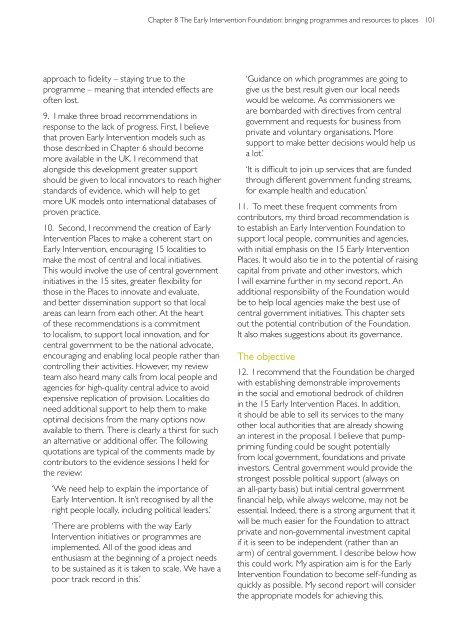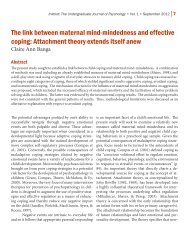early-intervention-next-steps
early-intervention-next-steps
early-intervention-next-steps
Create successful ePaper yourself
Turn your PDF publications into a flip-book with our unique Google optimized e-Paper software.
approach to fdelity – staying true to the<br />
programme – meaning that intended efects are<br />
often lost.<br />
9. I make three broad recommendations in<br />
response to the lack of progress. First, I believe<br />
that proven Early Intervention models such as<br />
those described in Chapter 6 should become<br />
more available in the UK. I recommend that<br />
alongside this development greater support<br />
should be given to local innovators to reach higher<br />
standards of evidence, which will help to get<br />
more UK models onto international databases of<br />
proven practice.<br />
10. Second, I recommend the creation of Early<br />
Intervention Places to make a coherent start on<br />
Early Intervention, encouraging 15 localities to<br />
make the most of central and local initiatives.<br />
This would involve the use of central government<br />
initiatives in the 15 sites, greater fexibility for<br />
those in the Places to innovate and evaluate,<br />
and better dissemination support so that local<br />
areas can learn from each other. At the heart<br />
of these recommendations is a commitment<br />
to localism, to support local innovation, and for<br />
central government to be the national advocate,<br />
encouraging and enabling local people rather than<br />
controlling their activities. However, my review<br />
team also heard many calls from local people and<br />
agencies for high-quality central advice to avoid<br />
expensive replication of provision. Localities do<br />
need additional support to help them to make<br />
optimal decisions from the many options now<br />
available to them. There is cl<strong>early</strong> a thirst for such<br />
an alternative or additional ofer. The following<br />
quotations are typical of the comments made by<br />
contributors to the evidence sessions I held for<br />
the review:<br />
‘We need help to explain the importance of<br />
Early Intervention. It isn’t recognised by all the<br />
right people locally, including political leaders.’<br />
‘There are problems with the way Early<br />
Intervention initiatives or programmes are<br />
implemented. All of the good ideas and<br />
enthusiasm at the beginning of a project needs<br />
to be sustained as it is taken to scale. We have a<br />
poor track record in this.’<br />
Chapter 8 The Early Intervention Foundation: bringing programmes and resources to places 101<br />
‘Guidance on which programmes are going to<br />
give us the best result given our local needs<br />
would be welcome. As commissioners we<br />
are bombarded with directives from central<br />
government and requests for business from<br />
private and voluntary organisations. More<br />
support to make better decisions would help us<br />
a lot.’<br />
‘It is difcult to join up services that are funded<br />
through diferent government funding streams,<br />
for example health and education.’<br />
11. To meet these frequent comments from<br />
contributors, my third broad recommendation is<br />
to establish an Early Intervention Foundation to<br />
support local people, communities and agencies,<br />
with initial emphasis on the 15 Early Intervention<br />
Places. It would also tie in to the potential of raising<br />
capital from private and other investors, which<br />
I will examine further in my second report. An<br />
additional responsibility of the Foundation would<br />
be to help local agencies make the best use of<br />
central government initiatives. This chapter sets<br />
out the potential contribution of the Foundation.<br />
It also makes suggestions about its governance.<br />
The objective<br />
12. I recommend that the Foundation be charged<br />
with establishing demonstrable improvements<br />
in the social and emotional bedrock of children<br />
in the 15 Early Intervention Places. In addition,<br />
it should be able to sell its services to the many<br />
other local authorities that are already showing<br />
an interest in the proposal. I believe that pumppriming<br />
funding could be sought potentially<br />
from local government, foundations and private<br />
investors. Central government would provide the<br />
strongest possible political support (always on<br />
an all-party basis) but initial central government<br />
fnancial help, while always welcome, may not be<br />
essential. Indeed, there is a strong argument that it<br />
will be much easier for the Foundation to attract<br />
private and non-governmental investment capital<br />
if it is seen to be independent (rather than an<br />
arm) of central government. I describe below how<br />
this could work. My aspiration aim is for the Early<br />
Intervention Foundation to become self-funding as<br />
quickly as possible. My second report will consider<br />
the appropriate models for achieving this.



